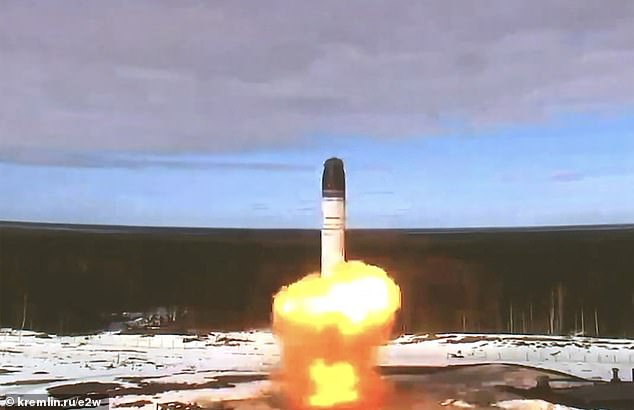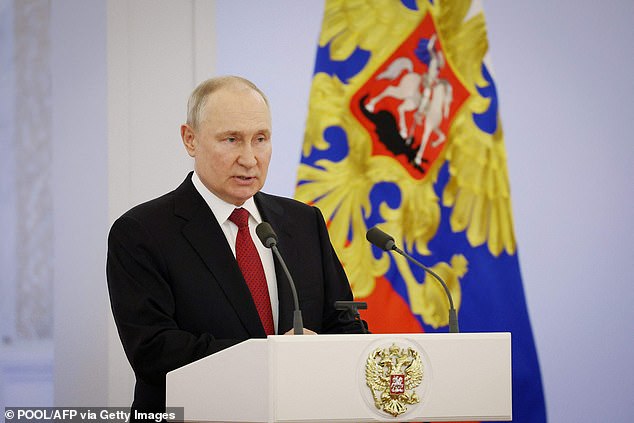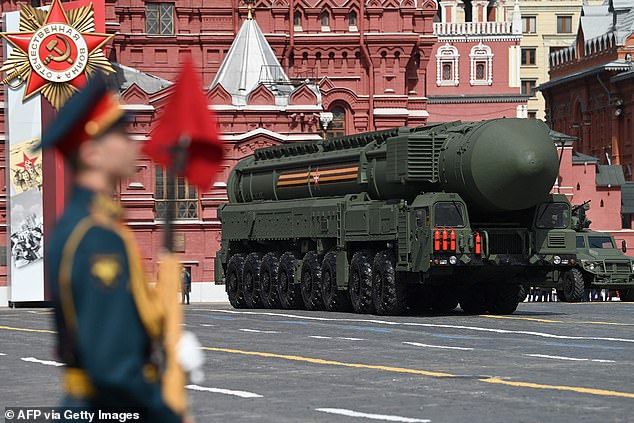EXCLUSIVE – How Putin’s EMP nukes could trigger ‘the collapse of society’: Unstoppable blast from space would cut off water and energy, leaving citizens to starve or die in resulting panic-fuelled violence
Amid the brutal conflict that has gripped Ukraine since the Russian invasion in February 2022, the world has witnessed a series of devastating weapons that have reshaped the landscape of modern warfare.
From Moscow’s ominous Iskander missiles to the terrifying presence of cluster munitions and the ever-threatening kamikaze drones, the war-torn region has become a melting pot for cutting-edge military technology.
But now a new and potentially catastrophic threat looms: the specter of a Russian EMP attack.
The Russian government has not shied away from openly hinting at a sinister end to the war in Ukraine, and media mouthpieces have issued a series of nuclear threats against not only Kiev, but also its British and American allies.
In reality, deploying a nuclear warhead on the battlefield in Ukraine, or in a hateful attack on London or Washington DC, is a very remote possibility.
But an EMP strike is emerging as a brutally effective alternative, capable of plunging entire societies into chaos.
With the help of military history and technology expert Dr William Forstchen, MailOnline delves into the chilling potential of such an attack and examines the unprecedented devastation it could wreak in Ukraine – and in Britain.

A Russian Sarmat-2 intercontinental ballistic missile launch

Russian President Vladimir Putin
What exactly is an EMP weapon and how does it work?
An electromagnetic pulse weapon is essentially a nuclear bomb or missile detonated high above the Earth. An EMP effect is created by detonating a large nuclear bomb – with a force of somewhere between 60 and 80 kilotons – about 200 miles above the Earth.
The radiation from the nuclear blast is absorbed by the atmosphere, but the explosion also creates a massive electrostatic discharge known as the Compton effect.
That flows to the earth, where every wire and every electrical system actually functions as an antenna. The enormous charge overloads the system, blows up the electrical grid and short-circuits the components of electronic products.
Non-nuclear, localized EMP devices exist, which work by releasing a burst of energy in the radio frequency or microwave spectrum, which can overload and damage electronic components and systems. But these are only effective on a small scale – we’re talking a few city blocks.
What are the immediate and long-term effects of an EMP strike?
The immediate effect would destroy the electrical infrastructure. Water and energy supplies would be immediately turned off, and any heating system that does not burn firewood would no longer be available.
Cars, computers, telephones, transportation, banking… anything that uses electrical components or relies on electronic systems to function ceases to function.
Unless you live completely unsupported in the wilderness, this essentially deprives you of access to water, warmth and food – three elements of the basic level of Maslow’s hierarchy of needs – and would essentially result in societal collapse.
The long-term effects of an EMP strike are therefore a dramatic population reduction.
Over the course of weeks and months, most people living in cities would die of thirst or starvation – or be killed by panic and violence, and anyone needing regular medical treatment would have no chance of survival.
Access to the few food and water supplies left would naturally be controlled by the government and military, or by the most effective and violent armed gangs.
In the US, Department of Energy studies estimate that it could take as long as five years to bring just 20 percent of the electricity grid back online. At that point, modern society would have all but collapsed. I imagine Britain would face a similar scenario.
Is there a way to defend against an EMP attack?

William R. Forstchen is a New York Times bestselling author of the One Second After series and professor of history at Montreat College in North Carolina
An EMP attack is a line-of-sight event, and because the weapon is detonated hundreds of miles above Earth, the target area is enormous. We came to understand this in 1962 after the Starfish Prime nuclear test on Bikini Atoll.
That bomb had a yield of 1.4 megatons – small compared to today’s nuclear weapons – but the EMP blast still disrupted electrical and communications systems in Hawaii, more than 500 miles away from the detonation point.
There is no real way we can protect ourselves from an EMP explosion because of the way it is deployed. Unlike Britain, the United States has an ICBM nuclear missile defense system: it has dozens of missiles on standby, ready to intercept a nuclear missile and blow it up in space before it re-enters the atmosphere and hits Earth hits.
But an EMP attack relies on the author detonating the nuclear missile hundreds of miles above the atmosphere – the missile can activate within 15-20 minutes of launch, making it essentially impossible to intercept in time.
On site, we have very limited capacity to protect the power grid from an EMP attack, but that would require a major industrial upgrade. Many components underlying US and UK network systems are decades old.
Replacement parts are needed, but most of these are developed abroad and we do not have an emergency stock.
Authorities should initiate a massive upgrade programme, which would involve designing and building key parts of the electricity grid, such as transformers and substations, to withstand the effects of an EMP.
This can be achieved by shielding and surge protection, but this would still only have a limited effect.
What are the chances of an EMP strike?
In an address to the United Nations during the Cuban Missile Crisis, President Kennedy once said, “Today, every inhabitant of this planet must contemplate the day when this planet may no longer be inhabitable. Every man, woman and child lives under a nuclear sword of Damocles, hanging by the thinnest of threads, which can be severed at any moment by accident, miscalculation or madness.”
It’s hard to imagine a scenario in which an EMP attack from Russia is a calculated response to something unfolding on the battlefield, because the implication of such an attack would be WWIII.
But in a moment of weakness or madness, it is possible that Putin, backed into a corner as power slips and opponents close in, could hastily authorize such an attack.
An EMP attack would open Pandora’s box – it’s been 80 years since we’ve used nuclear weapons in anger, and for good reason – it would be a quick and sharp downward spiral toward mutually assured destruction.

In this file photo taken on May 7, 2022, a Russian Yars intercontinental ballistic missile launcher parades through Red Square during the dress rehearsal of the Victory Day military parade in central Moscow on May 7, 2022
Dr.’s concern Forstchen about a moment of madness – or even a simple accident – leading to an EMP attack or nuclear war is not without merit.
Since the detonation of the first atomic bombs, a series of near misses and technical mishaps have brought the world to the brink of total destruction.
One of the most terrifying near misses occurred when Stanislav Petrov, a Russian radar operator, made a split-second decision that prevented a catastrophic nuclear war as Cold War tensions between the United States and the Soviet Union were at their peak. were a highlight.
On September 26, 1983, Petrov was on duty at a secret Soviet missile warning facility when his instruments suddenly showed the worst: multiple incoming US nuclear missiles headed for Moscow.
But instead of following protocol by launching a retaliatory strike – or even informing his superiors – Petrov trusted his instincts and doubted the accuracy of the data.
He reasoned that a real American attack would require more than just a handful of missiles, and that the newly designed system was more likely to have flaws and inaccuracies.
His gut feeling paid off: analysts concluded that the false alarm reported by the system was likely caused by a rare reflection of sunlight on the cloud tops.
Petrov’s courageous decision not to respond undoubtedly saved millions of lives and prevented nuclear war.
But with tensions between Russia and the West at an all-time high, the possibility of nuclear conflict – or a devastating EMP attack – can never be completely ruled out.
- William R. Forstchen is a New York Times bestselling author of the One Second After series and professor of history at Montreat College in North Carolina. He holds a PhD from Purdue University with a concentration in military history and technology.
